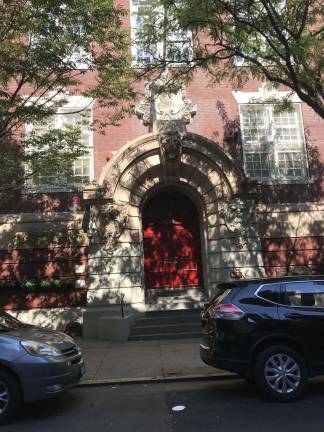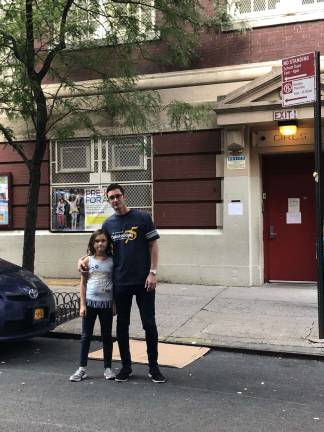the school that time forgot


There is no place to play but the street for the children of P.S. 290 on the UES — so their parents, beset by safety concerns, have cast their gaze upon the roof
BY DOUGLAS FEIDEN
There are 505 public schools in Manhattan. Virtually all of them house gymnasiums or provide other designated spaces for mandated physical education programs in their buildings or off campus.
And then there is P.S. 290 on the Upper East Side. It has no stand-alone gym. No adequate courtyard space to hold recess. No “gymnatorium,” or converted auditorium. No indoor play space nearby.
What it does have is the street, mostly closed to traffic, in front of the school, where more than 600 elementary students are forced to go for their recess, exercise and other physical activities.
That has raised safety and security concerns — and fueled a campaign by parents, politicians and school administrators to retrofit the rooftop for use as an outdoor play space or green roof or both.
Advocates want to get the kids off the street and into protected space atop the building. To fund those efforts, they’ve held bake sales, raised cash through Participatory Budgeting and banked $2.25 million.
But cost estimates keep skyrocketing. Initially pegged at $2.8 million, projections first doubled. By some accounts, they trebled. Hard figures aren’t easy to come by. The city’s School Construction Authority, or SCA, which builds and renovates schools, didn’t provide them by press time. Nor did the city’s Dept. of Education (DOE).
Still, more than four years after the proposal first surfaced, one thing is clear: The drive to green the roof and transform it into a “safe recess space” for children appears to have stalled. At least for now.
“I know my fourth-grade daughter will never reap the benefits of this project,” said Tom Wrocklage, an attorney, member of the executive board of the school’s PTA and father of nine-year-old Georgia.
“It has been ongoing since 2014 when she was in kindergarten, and it won’t be completed by the time she leaves,” he added. “But all the other children and parents should feel safe and secure in the school as well.”
State Assembly Member Rebecca Seawright and City Council Member Ben Kallos, both of whom represent the Upper East Side, have allocated state and city funds respectively for the project and are seeking to get it back on track.
“No child attending New York City public schools should have to play in the street during recess,” Seawright said.
“The rules of engagement have changed,” she added. “It is no longer acceptable to allow the system to place our children in harm’s way. There’s no choice between fears for their safety and safe play spaces.”
P.S. 290 was built at 311 East 82nd Street in 1903, and its physical plant, largely untouched since then, is a throwback to an era when public schools had no gyms, physical education was not an imperative — and the street was the lone preferred venue for exercise needs.
Now, 115 years later, the five-story, red-brick schoolhouse between First and Second Avenues, re-launched in 1991 as the Manhattan New School, is one of only eight public schools in the borough that offers no designated space for phys-ed.
The city’s Dept. of Transportation provides the main play area for P.S. 290 — giving it permission to temporarily shut down 82nd Street.
A century ago, and continuing into the 1950s, “recess-in-the-street” was a common practice. But time-capsule conditions are out of whack with contemporary risks and safety standards, parents and elected officials contend.
“It’s insane and absurd that our children today have nowhere to play but the street in the most densely populated city in the United States,” Wrocklage said.
While the street is “technically closed” to traffic, he said, the reality is quite a bit different:
Some 70 students from two separate classes, each with roughly 35 kids, play outside during recess at any given time as vigilant school personnel watch over them. Two crossing guards, one at each avenue, are also in position, and there are a few flimsy metal dividers placed at the Second Avenue entrance to eastbound 82nd Street, he said.
WHAT EVERY PARENT FEARSIt is not enough, Wrocklage added. The barriers can easily be moved, enabling cars and trucks to traverse the block all through the day — and pass alongside large groupings of third-, fourth- and five-graders who spill onto the street during recess.
Adding to the anxiety of the parents are two recent catastrophic terror attacks, the Parkland school shooting in Florida, which killed 17 students and staff, and the truck-ramming spree in lower Manhattan, which killed eight tourists and ended across the street from Stuyvesant High School.
“Somebody who wants to do something awful can rent a truck, move the barriers and mow down 60 kids playing in the street pretty quickly, and there’s nothing we can do to stop them,” Wrocklage said.
Even before those horrors, the PTA and the school’s principal, Doreen Esposito, had been working with Kallos, Seawright and city education officials to develop a green roof or other outdoor rooftop space.
Esposito, who has a first-grader in the school, even signed a petition to the SCA “urging our leaders to act now to retrofit the P.S. 290 rooftop as a play space.” She did so as a parent, not in her official capacity as principal, she told the PTA.
But it’s no easy task for a city institution to convert a roof. Manhattan’s private schools, it turns out, have a much better track record than the city’s public schools at such endeavors — in part because their procurement process is usually speedier and more streamlined.
On the Upper West Side, for instance, there are two on West End Avenue alone:
The Calhoun School’s green roof learning center, which opened in 2005, appears to be the first eco-friendly school roof offering outdoor science and environmental studies, while a mile to the south, the Abraham Joshua Heschel School created a 16,000-square-foot landscape design with a greenhouse, organic garden and play space.
Across town, Regis High School on East 84th Street boasts a 20,000-square-foot green roof complete with biodiversity lab and astronomy observation area. Meanwhile, P.S./I.S. 217, a public school on Roosevelt Island, broke ground on a green space this summer.
P.S. 290 faced a rockier road. Kallos in 2015 allocated $500,000 in discretionary capital funding; he followed up with another $520,000 in 2016; and then, after the capital project secured more votes, 802, than any other project in Participatory Budgeting, he came up with still another $500,000.
Meanwhile, Seawright allocated $500,000 in early 2016, and the PTA raised $250,000 from several bake sales, movie nights and Halloween dances.
Drawing on the Kallos funds, the SCA, which didn’t respond to questions, spent $347,000 on scoping for the project, including consulting, environmental, engineering and architectural fees.
Somewhere during this pre-construction process, the price tag, which in 2016 had been estimated at $2.8 million, began to go, well, through the roof.
At issue was whether the project would be made ADA accessible — the school has no elevators — necessitating major interior construction to build a lift from the ground floor to the roof, or whether a waiver would be granted by the Mayor’s Office for People with Disabilities, permitting the project to proceed without an elevator.
The DOE didn’t respond to questions by deadline, so it wasn’t possible to determine the status of a waiver request, if any.
“The city’s procurement process is broken,” Kallos said.
“We are required to raise funds for the full expected cost of a project – before the city will do any on-site inspection to develop a more accurate cost estimate,” he added.
Kallos said it was only after the P.S. 290 community had rallied for the project and won Participatory Budgeting funding, to which he added additional monies, that the city finally inspected the site — “only to find that it would cost many times the original estimate.”
“Situations like these should be avoidable, so projects don’t get stuck in a multimillion dollar deficit,” Kallos said.
What comes next? “We must stand with the parents of P.S. 290 — and protect their children as we would our own,” Seawright said.
invreporter@strausnews.com